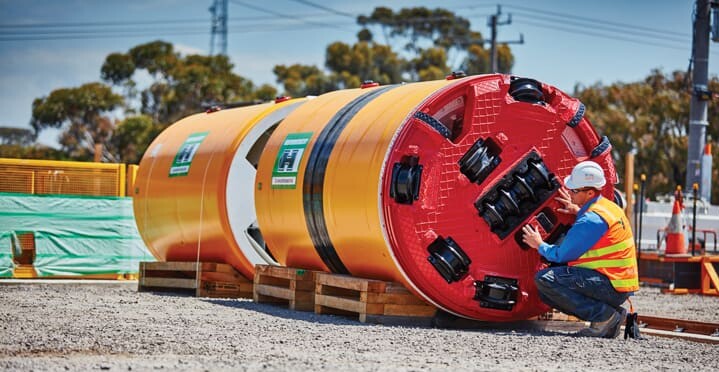
By Ash Hamer, Major Projects Manager, Yarra Valley Water, and Australasian Society for Trenchless Technology’s Young Person of the Year 2022
The trenchless industry is an essential part of delivering infrastructure for Yarra Valley Water customers. Its assets (mainly sewer mains) have been getting larger and more complex over the past decade due to population growth. Here, Yarra Valley Water’s Major Projects Manager, Ash Hamer, explains how the utility has relied heavily on trenchless construction methods to deliver more than $200 million worth of work to expand and improve Melbourne’s water and sewer network over the past ten years.
Protecting cultural heritage is very important to us as we work to deliver our essential services – it’s part of our commitment to caring for Country. We always endeavour to avoid disturbing environmentally sensitive areas and Aboriginal cultural heritage during our construction work.
With trenchless technology there’s less digging, which significantly reduces potential damage.
It can be complex work due to ground conditions, so it’s important that we work closely with our delivery partners to manage key risks, reduce impacts to the community and environment and ensure successful outcomes.
One of our most significant recent achievements is delivery of the $80 million Lockerbie Main Sewer Project – one of Yarra Valley Water’s largest ever capital works projects. It runs over 9km between Donnybrook and Wallan in Melbourne’s north.
As part of the project design, we worked with our design partner Jacobs and the Wurundjeri Woi-wurrung Cultural Heritage Corporation to identify the potential impact that excavation might have on culturally sensitive areas.
Trenchless drilling technology was used to minimise disruption to sensitive sites along the construction route. Where areas could not be avoided, we went beyond what is required in a standard Cultural Heritage Management Plan by establishing a collaborative research paper to better understand the significance of the stony rises in this region.

We typically use micro tunnelling and horizontal directional drilling across our major projects. Our focus is on micro tunnelling for large diameter sewer construction such as for Lockerbie (DN1400 to DN600) and our Amaroo (DN1600), Kalkallo Creek (DN1200), Epping (DN1600 – 1800), Donnybrook East (DN1000 to DN600), and Donnybrook Link (DN 800) projects.
Utilising horizontal directional drilling on the Doreen transfer main meant that we could limit the need for vegetation removal, which reduced our impact on the environment. Epping Main sewer was a highlight due to the depth being 40m and therefore requiring significant logistics to just get the drilling and tunnelling machines in place. We’ve also been leading the implementation of glass reinforced plastic pipe, which has successfully supported delivery of projects while ensuring longevity of assets.
Working around existing infrastructure
As well as cultural and environmental sensitivity, another factor that determines the use of trenchless technology on our projects is the presence of existing infrastructure, such as buildings or roads. Trenchless becomes more economical and safer than open cut trenching when the depth exceeds about eight metres.
Trenchless technology can have its challenges due to the risk of unexpected ground conditions that can be encountered. For example, construction in the northern growth corridor around Donnybrook is especially difficult due to high strength rock from multiple lava flows intersected with mixed/soft ground conditions that make tunnelling challenging.

Ensuring that we carry out appropriate ground investigations and risk discussions is critical to setting up these projects for success. There needs to be significant collaboration between clients, designers, suppliers, and contractors to ensure successful project delivery.
Trenchless technology is critical to the future of the water and utilities sector. The combination of aging infrastructure and population growth means that our work will increasingly need to be completed in more built-up areas.
This will require innovation and technology to renew and install essential infrastructure for the future. Trenchless technology also has a key role in reducing a project’s carbon footprint by limiting the backfill needed for open trenching (backfill being a significant contributor of embodied energy).
As the industry continues to develop and grow there are exciting times ahead for trenchless technology in Australia. As a utility, it’s important that we continue to engage with the trenchless industry across all spectrums so we can deliver our work with the least possible impact.
Only by working together will we be able to achieve our commitment to caring for Country and deliver on our purpose to support the health and wellbeing of our customers, and create a brighter future for communities and the natural environment.















